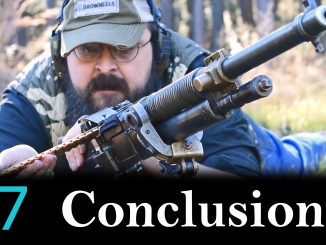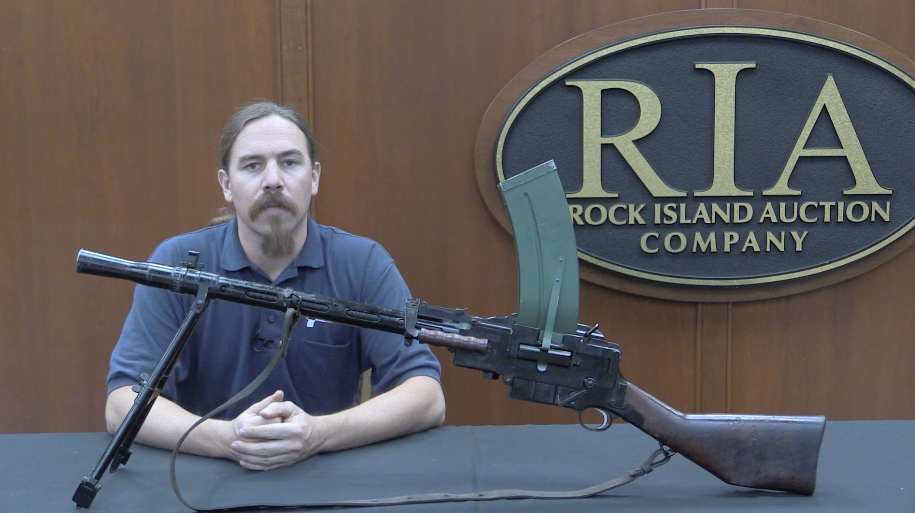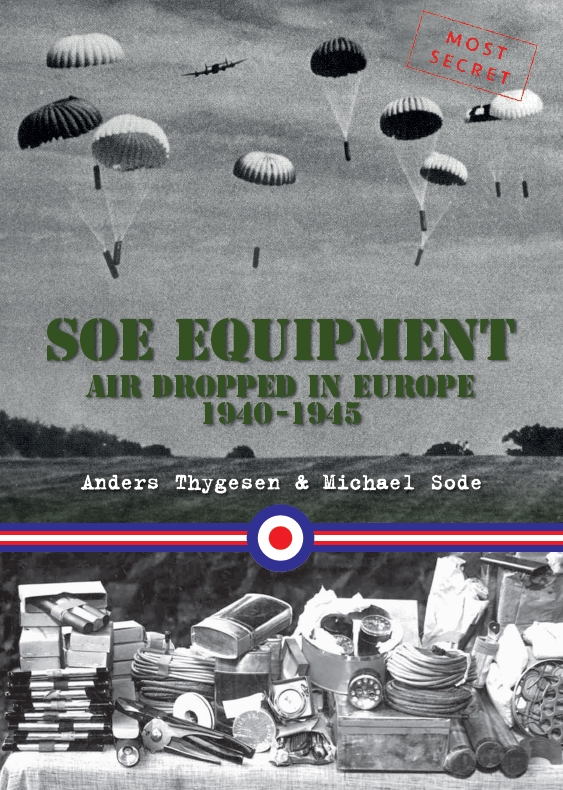The first repeating rifle used in combat by a military force was a flintlock system developed by the Kalthoff brothers. It was adopted in the 1640s by the Danish Royal Guard, who purchased a bit more than 100 of the guns, and used them successfully in the Siege of Copenhagen in 1659. The Kalthoff is a .54 caliber flintlock rifle with a magazine of 30 balls under the barrel and a powder storage compartment in the buttstock. A lever under the action is rotated forward 180 degrees and then back to completely reload the rifle – this action loads a ball into the chamber, seats it fully in place, loads powder behind it, primes the pan, cocks the hammer, and closes the frizzen. This was an amazing amount of firepower in the mid-1600s, and the mechanism in the gun is brilliant.
The Kalthoff brothers (Peter, Mathias, Caspar, Henrik, and William) spread out across Europe working for many royal courts although it was in Denmark where their gun saw the most substantial military use. The system would lead to other repeating flintlock designs like the Lorenzoni, but these did not really meet the quality of the original Kalthoffs (in my opinion). However, the system was very expensive to make and rather fragile to use. By 1696 the Danes had taken them out of service in favor of simpler and more durable designs. Kalthoffs today are very, very rare, and it was an incredible privilege to be able to take this one apart to show to you. Many thanks to Jan, its owner, for letting me do that!




“(…)It’s a .54 calibre gun, powder charge
is 33.1 grains of 2F black powder.(…)”
How it does compare to European 1650s singe-shot flintlock long fire-arms?
Later than the 1650s, but from a quick check 1722 Brown Bess was .75 with 165 grains, and the 1717 Charleville .69 with 154-200 grains of powder. I don’t think either was a huge jump in power.
Black powder load calculator;
https://weatherby.dk/BP/calc/BlackPowderCalc.htm
It gives MVs of;
.75 (600 gr) MV 1,307 F/S, ME 2,276 FPE
.69 (470 gr) MV 1,371 F/S, ME 1,962 FPE
.54 (230 gr) MV 915 F/S, ME 427 FPE
All assuming FFg powder equivalent to Goex.
So while the Kalthoff wasn’t as powerful as the muskets of its day, it was more powerful than any pistol in service, had a much higher rate of fire, and was certainly more accurate than all but the best muzzle-loaders.
Getting hit by the equivalent of a .45 ACP at 200 meters would be both more debilitating- and demoralizing- than being missed by the equivalent of a 12-gauge Fosters type slug at half that range.
cheers
eon
“(…)Kalthoff wasn’t as powerful as the muskets of its day, it was more powerful than any pistol(…)”
So like intermediate cartridge but about 300 years earlier?
Pretty much. Rapid fire, low recoil impulse and decent accuracy out to practical combat range.
A very close analogue? The Henry repeating rifle or the Winchester Model 1866, both in .44 Henry Flat.
cheers
eon
A rifle with the real equivalent of a heavy pistol charge of powder-not the greatest setup, but for the time and battlefield conditions of the era, not at all a bad design. A specialist unit weapon. I suspect these were very costly to manufacture and that maintenance was a major issue.
Amazing! Thanks for finding this, and to the owner for allowing detailed examination.
The use of transfer chambers for the powder and ball instead of direct loading are especially remarkable.
This certainly reminds me of John M. Browning’s ingenuity in analyzing the mechanical steps needed and devising efficient ways to accomplish each. Of course, that is the easy part, it becomes much harder to then combine them into a unified mechanism. Made even harder if it is to stand up under repeated use.
To make a single working example is amazing. To manufacture by hand with no machine tools and no precision measurement devices is great craftsmanship. To then make a hundred similar guns (not interchangeable, of course) certainly was a feat requiring royal sponsorship and funding.
One of the most amazing (and forgotten if ever known) guns you have brought to us. THANK YOU!
They were like ancient tool and die makers. Or maybe a cross between a watchmaker and gunsmith. Great presentation.
The drill involved in tipping the gun back for the ball to load, and forward for the powder, must have been hair raising under the stress of battle.
I suspect the rifled barrel would compensate for the lighter bullet and propellant at normal fighting range
I’d say it was no more difficult than the drill for reloading a single-shot muzzle-loading musket under the same circumstances. Which soldiers drilled on constantly back then.
The most important difference would be that the Kalthoff could be effectively reloaded and fired again, repeatedly, while on the move. Without slowing down or stopping.
This was what killed Pickett’s troops at Gettysburg three hundred and four years later- literally. Advancing across roughly 1 kilometer of flat land
https://upload.wikimedia.org/wikipedia/commons/5/56/Pickett%27s-Charge.png
at a walk for the first 600 meters or so, then a quickstep for the next 300, and then the double quickstep and the charge for the last hundred, it took them about fourteen minutes to cross the field. During which time they were under fire from the stationary Union rifle line firing at volley rate (three rounds per minute, by rank) and the Union artillery (firing at roughly the same rate with spherical case and roundshot until they were within 300 meters, then firing fixed canister at four rounds per minute).
In that time, the Confederate soldiers could not effectively fire and reload. To reload a muzzle-loading rifle or musket at the walk requires either balancing it on the shoulder, trailing it, or simply stopping and standing or kneeling while reloading.
The first two methods slow you down and are easily fumbled. The last two are right out of the drill book- but they trap you motionless in the enemy’s kill box.
This is the “secret” of the failure of that “charge”.
A repeater like the Kalthoff could be reloaded “on the move” with comparative ease. Tilt muzzle down, turn trigger guard through half-circle forward, tilt muzzle up, turn trigger guard half-circle backward, level, sight, shoot.
With thirty rounds on tap, stopping to reload the magazines would be a job for after you were ensconced in the enemy’s (former) position.
Troops so armed would be able to execute a breakthrough maneuver, followed up by troops armed with regular muzzle-loaders. Much as Samuel Colt’s 1st Connecticut Revolving Rifles were intended to do in the American Civil War.
As William B. Edwards said of the latter in Civil War Guns (Stackpole 1962- available free at archive.org), the Danish Royal Guard armed with Kalthoff repeating rifles could have been the world’s first “storm troops”.
clear ether
eon
You look at Pickett’s Charge, and then Lee’s reputation as a tactical/operational/strategic “genius”, and you have to start wondering if that reputation is either undeserved, or he was fighting for the Union side.
I’ve heard a lot of defenses of the decision leading to sending Pickett in, but none of them ring even the slightest bit valid, to my understanding of war during that era. It’s not like this was the first battle where rifled muskets were commonly used, nor is it as if the Union hadn’t begun demonstrating some basic competence. Pickett’s Charge starts to look like a “Well, let’s throw that on the wall, and see if it sticks…” sort of affair.
Or, Lee was trying to lose the war.
Either way, got a lot of good Confederate soldiers killed, to no real effect. The entire idea of raiding north into the Union was stupidity on ice, in the first place. Had the South followed a Fabian strategy of making the Union come after them on their home terrain, and maintained some restraint…? Things might have eventuated differently, and let to a stalemate that would have left the Confederacy intact. Imagine Lincoln flinging McClellan southwards, having them get their asses beaten in detail, and then trying to win the next election with a failed campaign to invade the Confederacy… Plus that, the international order of the day would have been somewhat placated and reassured by the Confederacy not demonstrating expansionist tendencies…
You look at it from a certain point of view, and it’s like Lee was helping Davis lose the war with overambitious strategy.
I’ve long suspected it was because Lee had inadequate information from his own Ordnance people.
His artillery did a prep with spherical case and shell to “soften up” the Union position prior to the advance, just like The Book said.
What nobody apparently knew was that the new batch of time fuzes, made not at Richmond but in South Carolina, consistently burned slower; i.e. if they were cut for three seconds they would burn five or six.
Which meant the shell and case meant to burst over the Union FLOT were instead bursting over the woods and the Taneytown Road some 250 meters further back. Where the Union field artillery was limbered up waiting to be called forward.
After about ten minutes of putting up with that, the slightly hurt but thoroughly pissed redlegs moved up on their own accord, just ahead of an order from Meade to do it anyway.
So when the Confederates advanced, they were facing not just a Union rifle line that was both unhurt and which had had almost half an hour to observe what they were forming up for and get ready for it, but also a lot of bruised and bloodied cannoneers who were looking for payback.
Their time fuzes functioned correctly, although they switched to first solid shot and then canister once the range dropped below about 600 meters.
The problem with the new time fuzes was discovered by tests after the battle. Nobody had thought to test them before they were issued.
Yes, when the Army split in two, the Confederate side got their fair share of the genuine idiots in Ordnance.
cheers
eon
Another great example of advanced designs devised early on that took centuries to become common due to cost of manufacture, quality of material, and having the bulk of the soldiers being able to deal with the complexity of the Manual of Arms.
I would love to see someone reproduce this rifle, taking advantage of modern materials and quality manufacturing to allow interchangeable parts for quick repairs.
This rifle has actually already been reproduced, taking advantage of modern materials, quality manufacturing, and other advances. In the process, also, they’ve managed to make it far less expensive. You can look up variants by googling for “AR-15”.
“(…)reproduce this rifle, taking advantage of modern materials(…)”
Which modern material should be used to get spark-making ability required by flint-lock to work?
Piezoelectric crystal.
Clap-on, clap-off,
the clapper.
The one point I don’t see made here is that this is basically a “fortress gun” that had to be kept close to its base of operations with proficient gunsmithing support… You would not want to hand a Kalthoff over to, say… Lewis & Clark’s expedition. The Girandoni air rifle they were handed was a lot more robust, if somewhat more difficult to keep in operation. Historically, they managed that feat.
I think that all too many people fail to account for human ingenuity when it comes to wanting to kill other people; no matter what legalistic restrictions you try to place on things, someone, somewhere will figure out a work-around.
Casual acquaintance of mine showed me a prospectus he had been given that managed to work its way around the strict letter of the California law on magazines. The proposed mechanism was ingenious, and about as complicated as this Kalthoff rifle, but it gave the user something like 40 rounds of ammo on tap. I’m not sure if the design would have passed muster with the idjit types administering the law down there, but… Nonetheless, someone managed a way around the law’s letter. I still wonder if it would have worked “in the flesh”, so to speak.
California’s “bullet button” magazine catch is a similarly nonsensical restriction but even simpler to deal with.
Have a U-shaped plastic piece that snaps on through the trigger guard area, with a hinged tab at one end that has a simple nubbin on its inner side. Press on the tab to depress the “bullet button”.
Being a snap-on “gadget”, it’s not a permanent “modification”.
As Cooper said, silly laws promote transparent evasions.
cheers
eon
A real problem with this system, no matter how clever the design, is needing high quality, consistent black powder. The powder has to be of uniform grain size and flow readily from the storage chamber to the breech. So “keeping your powder dry” becomes paramount. Another factor in the correctness of your statement about this being a “fortress gun”.
By the mid 17th Century, black powder production in Europe was almost exclusively a possession of the respective national governments, with industrial production methods and decent quality control.
Danish military black powder was pretty much the same as French or English, being of the “ideal” mix of 75% saltpeter, 15% charcoal and 10% sulfur. Purity of the ingredients was high, and the mixing, caking, grinding and sieving for size was at least as good as the French, who invented the still-used grain sizing system (Fg, FFg, FFFg, etc)about that time. Quality control was tight and the inspectors knew their business, as did the powder makers.
So the Danish Royal Guard, whose weapons required high-quality FFg powder, no doubt got exactly that from their King’s own powder mills.
cheers
eon
The Madsen LMG of its day. Only a helluva lot more ingenious. Dang right it was for the king’s own private fortress.
Well, the first thing I did was compare it to the brown bess powder charge “Prior to reading the comments” anyway, 1659… That is very impressive; shows you folk wanted to… They envisaged “Modern” guns, but it was hard/impossible to do; but they tried, this one tried anyway. I can understand why they didn’t all try, mind – As it was hard to try to do, metallurgy etc,etc quite. But still very good, I like the wee doors etc which hold everything in place. All good. Infact I don’t think seperating “Components” has fully ended… With actual modern tech, the brass cased cartridge; or self contained round, may not be the end of development yet… Especially, in larger guns. Maybe. .50 BMG up, say.